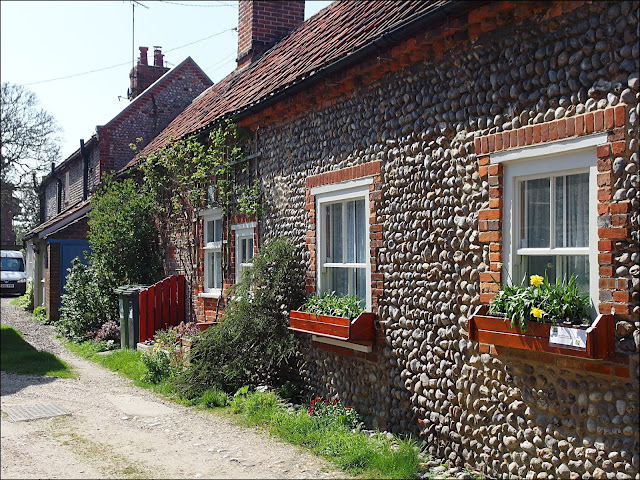Blakeney on the warmest day of the year so far: people sit on the many benches overlooking the boats on the tidal creek, a man sells ice-cream while next door a shop displays art and curios, the man in charge of the National Trust car park leans in the doorway of his wooden kiosk chatting to a friend, several people relax in the King's Arms pub and a few others watch the ducks and geese on the pond.
It'll get busier in the main summer season of course, there'll be fewer spaces on the benches and the ice cream seller may well have an assistant, but otherwise it will be "business as usual".
The village still clings to its seagoing traditions though in truth, apart from the boats that take tourists out to Blakeney Point to see the seals, there's not much activity here since the harbour silted up many years ago.
There was a time though when Blakeney, along with the neighbouring villages of Wiveton and Cley were the focus of a busy maritime trade. The coastline here formed a sheltered haven for sailing ships plying their trade around the coast and across the North Sea. The clearest evidence of this wealth that remains today are three very fine, larger-than-average churches.
Like many old ports there is a history of smuggling and piracy alongside the more legitimate trade. Ships that sought shelter in the haven found themselves relieved of their cargoes overnight.
The building above is known as Blakeney Guildhall but is now thought to be the cellar of a merchant's house which would have been used for storing his goods. It dates from the fifteenth century and is looked after by English Heritage.
In times past there were many tunnels and passages in the town which were probably very handy for anyone engaged in smuggling. A tale is told of a fiddler and his dog who explored one such tunnel playing a jig as he went. At length the music stopped and it was not till some days later that his terrified dog reappeared. The fiddler was never seen again.
It must be true because you can see it on the village sign. The only trouble is that similar tales are told at nearby Binham and at Anstey in Hertfordshire. Unless all fiddlers of yore felt compelled play tunes while to exploring tunnels it seems an amazing coincidence.
The Blakeney Conservation Area Duck Pond was founded in 1977 on the occasion of the Queen's Silver Jubilee and is stocked with many varieties of ducks and geese. That's a Ruddy Shelduck above.
And this gorgeous goose is a Red-Breasted Goose, a species which does turn up in the wild here occasionally though I've never seen one as close as this.
And now one of the men sitting on the benches overlooking the boats is going to make a purchase from the man selling the ice-creams.
Take care.











Hi John - oh England be though blessed with your history - wonderful to see - thanks so much ...cheers Hilary
ReplyDeleteOh John, what wonderful memories this post brought back. A few years ago the farmer and I spent a lovely week at the Blakeney Hotel. We had a room on the top floor with a balcony so that the farmer could go on long walks along the marsh path and I could soak up the sun and read the papers on the balcony.The food was delicious - every kind of fresh sea food.
ReplyDeleteLooks a lovely place on a gorgeous day like this!
ReplyDeleteLove the history of the communities, John. Wonderful photos, too. The birds are my favourites!
ReplyDeleteYou're a great storyteller, John! I'm always entertained an informed reading your posts. Such a beautiful little village. Love the first photo of the tidal creek, and intrigued with the brick and stone mixed construction of the homes.
ReplyDeleteEvocative narrative about a very picturesque part of Britain.
ReplyDeleteA lovely old seaside town.
ReplyDeleteSuch a lovely place!
ReplyDeleteI really love english villages, houses and countryside, all in your photos.
ReplyDeleteLovely photos !!
A few years ago I happened to be by the small harbour (more an inlet) in Wells-nest-the-Sea, just a few miles west of Blakeney. Suddenly, the tide started to rush in, setting all the boats, most of which had been sprawled lopsidedly in the mud, ahum as they responded eagerly to the incoming water. In minutes the water level went from near zero to full, I suppose because of the narrow channel. It was one of the most exciting things I've ever seen, and although I did once consult a tide table and try to repeat the experience, I didn't witness anything. I still don't know if this is a daily phenomenon, or if it's rare. I wonder if Blakeney ever has the same sudden incoming tide?
ReplyDeleteThe whole of the North Norfolk coast is known for having dangerous tides as, with the beach-gradients being so shallow a small rise in the tide can bring water flooding in to a wide area.
DeleteSuch a beautiful place, but that goose... WOW!!!
ReplyDeleteLovely place! I wish I could visit for as long as I want to.
ReplyDeleteLove the stone cottages! Great photos.
ReplyDeleteI love that stretch of coastline and the pretty villages. So many years since I visited... I must make plans to go again.
ReplyDeleteIt looks a lovely and very interesting seaside town to visit. I've never seen a red breasted goose before.
ReplyDelete